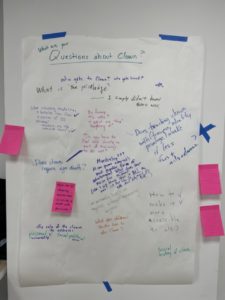“Examining Clown: Collaboratively Exploring Inclusivity in this Art Form”
Final Report December 2021
WHAT WAS OUR GOAL?
In 2021, a group of clowns embarked on an exploratory project. Could we meaningfully interrogate the discipline and art form of “clown”? We convened a group of professional clown artists and teachers to help us answer the following questions and more:
- How do we productively acknowledge the power dynamics present in each room?
- What is a teacher and how do we remove hierarchy from teaching?
- Is art always activism? When is it not? How do we galvanize artists to use their art to solve the social problems that they see?
- What happens in a co-intentional space?
- How do we ask better questions?
- How do we make the best art?
We reviewed eighteen applications and accepted eight for a total of twelve participants including the four organizers able to join in person. And we raised a total of $2613 to allow us to compensate participants $20 per convening to make it worth their while to attend.
WHAT HAPPENED?
The Examining Clown workshop was a true experiment — could a group of clowns meaningfully interrogate clowning? Could we consider our own positionality in both the discipline overall and more specifically in our own work as teachers and artists? Could we do this all without any leadership, in a horizontal format?
The first two sessions were full days (10am – 5pm) convened at the fantastic Mincey Room at Theater for the Oppressed in Times Square. These sessions were facilitated by the organizers, and involved development of community guidelines and setting of expectations. We began to examine our own positionalities through the creation of identity maps and a privilege walk. We also got a crash course in the racist history of Commedia Dell’arte and constructed our own full-body masks from newspapers. And we played, played, played.
In the subsequent six weeks, the format was opened to all participants to become leaders, and we invited each other to bring salient content and activities to share. Topics included gender and masking, removing the cop from your head to develop deeper characters, and Lucid Body work. Through this work, we began to ask the hard questions. How is identity related to art? Who is allowed to make art? Why do we have to talk about this, can we play about it instead?
CONCLUSIONS
Conclusions were captured in the final conversation as well as through exit surveys. What we found is that we have a lot more to learn! This time frame was not nearly long enough for us to get through all the relevant topics. This work was uncomfortable and important, and should be compensated more appropriately — i.e., not through a minimal stipend. We started to share work but would have liked more time to create something collaboratively. The surveys indicated that people found community and made connections to other artists through the process. Participants indicated that they became more aware of their own biases and came to the realization that everyone has their own “stuff” that they bring into clowning interactions.
Some anonymous feedback we’d like to share is:
“At the most basic level, I feel like there are facilitators who are interested in making the clowning landscape more equitable and inclusive, and I find that to be extremely inspiring. Whether or not it can be done, feels almost secondary. The fact that the questions are being asked means that there is an awareness of the issues that already makes me feel more seen and taken care of as a BIPOC clown.”
“We can’t change clowning, we can only change ourselves.”
“The best aspect of the lab was its very existence. The bringing together of thoughtful practitioners from such diverse backgrounds. Thank you for envisioning this and making it happen.”
“I don’t have a conclusion yet. It feels like I’ve planted a seed – it may take decades to see the flower and get the fruits out of this. But the process has started, at least for me.”
NEXT STEPS
We have identified three courses to pursue:
- Continued education for experienced teachers and facilitators
- Teacher training for those who are new to teaching
- An artist space for makers and creators
There is overlap in these categories, but part of the challenge of the first Lab is that we attempted to tackle all three, which widened the scope and didn’t provide enough focus. The next step will be to explore each one in more depth.
If you are interested in learning more about any or all of these potential next steps, subscribe to the Clown Gym newsletter at clowngym.com. We will be sharing future projects on this platform.
Thank you for reading this update and thank you for your continued support of clown. We love Clown!
Sincerely,
Ania Upstill, Aya Tucker, Emma Kaywin, Julia Proctor, Kevin Allen, Lex Alston, Omari Soulfinger, Rachel Lin, Sophie Ameiva
